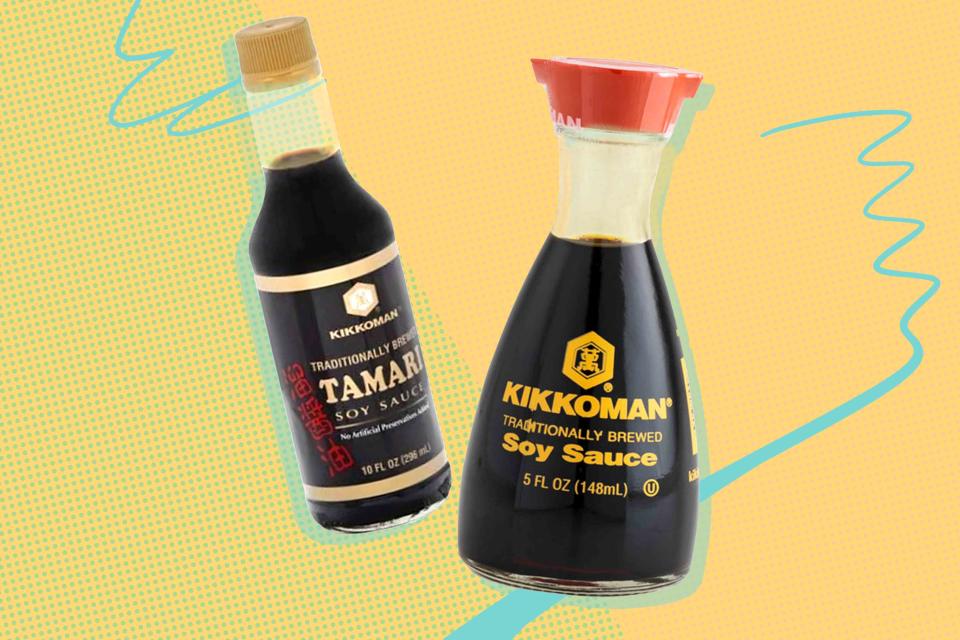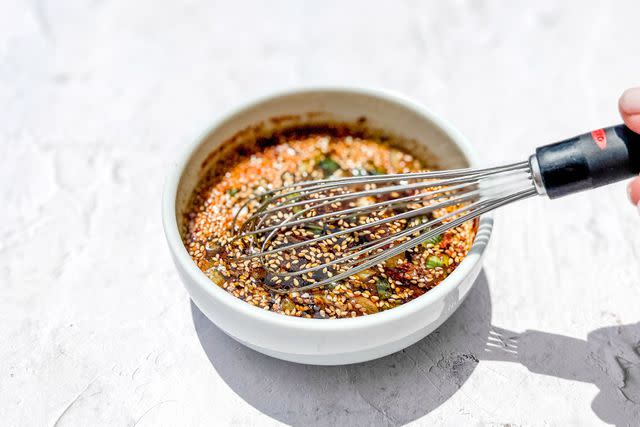Soy Sauce vs. Tamari: Kikkoman Explains the Difference
As a home cook do you need to stock both soy sauce and tamari, and can you use them interchangeably?

Simply Recipes / Photo Illustration by Wanda Abraham
Soy sauce was a staple growing up. The classic red double-spouted dispenser sat next to the stove, constantly being refilled from the gallon jugs of Kikkoman my family kept in the pantry.
While soy sauce is part of the East Asian cooking canon, its global appeal has increased wildly since I was growing up in the '90s. It’s no longer just found at Asian restaurants. It’s become a staple for many as a quick shot of umami to everything from gravy to salad dressing.
More recently, tamari has become a popular addition to the Western pantry. It’s often touted as a gluten-free soy sauce alternative, but is that the beginning and end of the differences between the two? Can they be used interchangeably? Do I need to stock both in my kitchen or just one bottle? I chatted with a Kikkoman representative and found out from one of the world's biggest makers of soy sauce.
What Is the Difference Between Soy Sauce and Tamari?
Soy sauce and tamari are similar but have subtle differences that make them distinct products.
Soy sauce is brewed with both soybeans and wheat. It has a thinner consistency and a more straightforward salty flavor.
Tamari is brewed with a higher concentration of soybeans and sometimes some wheat. This higher concentration of soybeans, Kikkoman explains, creates a richer, smoother taste and thicker viscosity.

Simply Recipes / Cynthia Christensen
Is All Tamari Gluten Free?
In short, no. Tamari is often naturally gluten-free, brewed only with soybeans. But some contain a trace amount of wheat, a practice that Kikkoman says provides a deeper and more complex flavor profile than using soybeans alone.
Some brands such as Kikkoman carry both a tamari brewed with wheat as well as a gluten-free tamari. If you’re shopping for wheat allergies or sensitivities, it’s smart to double-check the label to ensure the tamari you are purchasing is gluten-free.
Can I Use Soy Sauce and Tamari Interchangeably?
So do home cooks need to stock both bottles? Yes and no—it depends on your kitchen.
Kikkoman suggests that tamari’s darker, milder, and more aromatic qualities shine in applications that feature more delicate, refined flavors. Think dressings, dipping sauces, vegetables, and seafood. Its deeper, more robust flavor profile is more noticeable when fewer ingredients are used.
Tamari will work in most recipes where soy sauce is called for. If you only want to stock one bottle, or if gluten-free cooking is of importance to you, a bottle of wheat-free tamari generally works as a stand-in.
It doesn’t necessarily work as well in the reverse. Using soy sauce when tamari is called for can result in a sharper, saltier dish than what was intended. It may end up skewing the dish in a much more aggressive direction. Proceed with caution.
The decision to keep both soy sauce and tamari on hand is a personal one. If you’re the type of person with four different mustards and a half dozen different hot sauces in your refrigerator door, you’re also probably the type of person who would enjoy having both.
The Takeaway
Soy sauce and tamari are both brewed with soybeans. Soy sauce is also brewed with wheat; tamari is sometimes brewed with wheat. Check the label if you need a gluten free product.
Tamari is darker, more robust in flavor, and a bit milder than soy sauce. Tamari can generally be used in place of soy sauce, especially if gluten free cooking is a concern. Soy sauce is too sharp and salty to be used one-for-one for tamari.
Read the original article on Simply Recipes.

